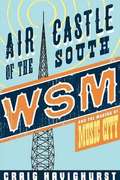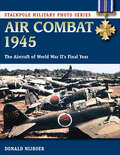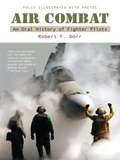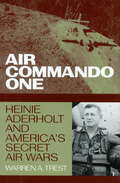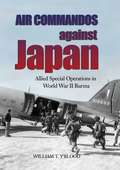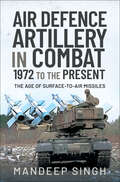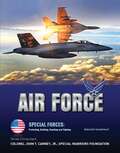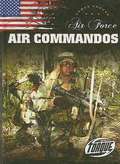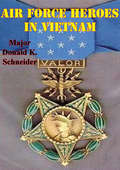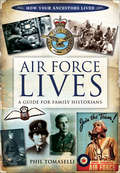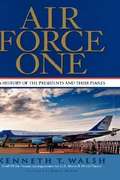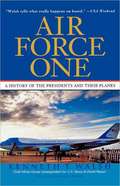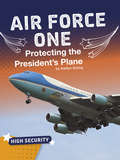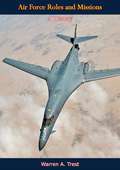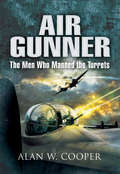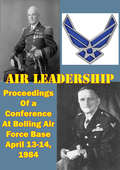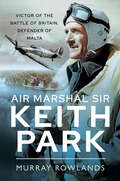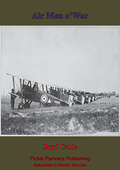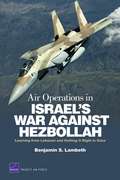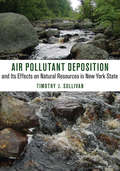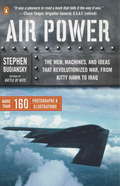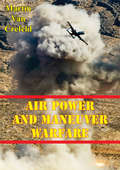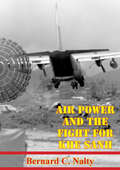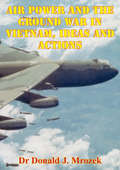- Table View
- List View
Air Castle of the South: WSM and the Making of Music City
by Craig HavighurstStarted by the National Life and Accident Insurance Company in 1925, WSM became one of the most influential and exceptional radio stations in the history of broadcasting and country music. WSM gave Nashville the moniker "Music City USA" as well as a rich tradition of music, news, and broad-based entertainment. With the rise of country music broadcasting and recording between the 1920s and '50s, WSM, Nashville, and country music became inseparable, stemming from WSM's launch of the Grand Ole Opry, popular daily shows like Noontime Neighbors, and early morning artist-driven shows such as Hank Williams on Mother's Best Flour. Sparked by public outcry following a proposal to pull country music and the Opry from WSM-AM in 2002, Craig Havighurst scoured new and existing sources to document the station's profound effect on the character and self-image of Nashville. Introducing the reader to colorful artists and businessmen from the station's history, including Owen Bradley, Minnie Pearl, Jim Denny, Edwin Craig, and Dinah Shore, the volume invites the reader to reflect on the status of Nashville, radio, and country music in American culture.
Air Combat 1945: The Aircraft of World War II's Final Year (Stackpole Military Photo Series)
by Donald NijboerA detailed and fully illustrated look at aerial combat in the closing year of WWII across all theaters of conflict. The final year of World War II witnessed the decline of the piston-engine fighter and the beginning of the jet age. Taking to the skies were tried-and-true fighters, improved versions of old aircraft, and newly developed jets, including prototypes that flew for the first time just before the war ended. In Air Combat 1945, historian Donald Nijboer examines these dynamic aircraft through hundreds of wartime photographs depicting operations across Europe, the Mediterranean, and the Pacific. This volume covers American Mustangs, Thunderbolts, and Shooting Stars; British Tempests, Spitfires, and Gloster Meteors; German Fw 190s, Bf 109Ks, and Messerschmitt Me 262s; Japanese Ki 100s, Raidens, and Tojos; and many more.
Air Combat: A History of Fighter Pilots
by Robert F. DorrIn Air Combat, veteran and military author Robert F. Dorr has collected dozens of interviews from combat veterans who have faced the enemy in the skies above-from the first days of World War II to the current war on terror. Each story offers a firsthand account of what it's like to be in the thick of the fight, describes the history, strengths, and weaknesses of each man's plane in detail, and offers readers a rare glimpse into the minds and hearts of those who dare to fight in the air.
Air Commando One
by Warren A. TrestAir-dropping agents deep behind enemy lines in clandestine night missions during the Korean War, commanding secret flights into Tibet in 1960 to support the anticommunist guerilla uprising, participating in plans for the 1962 Bay of Pigs invasion--even before the escalation of the Vietnam War, Brigadier General Harry C. "Heinie" Aderholt worked at the heart of both the U.S. Air Force and CIA special operations worldwide. In 1964 he became commander of the famed First Air Commando Wing, fighting to build up special operations capabilities among the American and South Vietnamese airmen. In 1966 and 1967 he and his men set the record for interdicting the flow of enemy trucks over the Ho Chi Minh Trail in Laos and North Vietnam.Drawing on official records, personal papers, and interviews with Aderholt and many who worked with him, Air Force historian Warren A. Trest details the life and career of this charismatic, unconventional military leader who has become a legend of the Cold War Air Force. He tells how Aderholt's vigorous support of low-flying, propeller-driven aircraft and nonnuclear munitions pitted him against his superiors, who were steeped in doctrines of massive retaliation and "higher and faster" tactical air power. In the mid-1960s Aderholt's clash with Seventh Air Force Commander General William W. Momyer reflected a schism that still exists between the traditional Air Force and its unconventional special operations wings. The book also integrates U.S. Air Force and CIA accounts of some of the most pivotal events of the past fifty years.
Air Commandos Against Japan
by William T. Y'BloodIn 1943 the U.S. Army Air Forces created what would become the Air Commandos, a unit that marked a milestone in tactical operations in support of British ground forces invading Burma. William T. Y'Blood tells the story of how these daring American aviators trained and went into combat using unconventional hit-and-run tactics to confuse the enemy and destroy their lines of communication and supply. The force comprised light planes to evacuate wounded, transports to move heavy cargo, fighters, gliders, helicopters, and more than five hundred men. The book describes how this top-secret force successfully attacked the enemy from the air, resupplied British commandos on the ground, and airlifted the wounded out of the battle area--eventually driving the Japanese out of Burma.
Air Defence Artillery in Combat, 1972 to the Present: The Age of Surface-to-Air Missiles
by Colonel Mandeep Singh“It covers, chapter by chapter the anti-air battle in wars from Yom Kippur (1973) onwards . . . a readable, well researched and well-presented book.” —Army Rumour Service (ARRSE)Anti-aircraft artillery truly came into prominence during the Second World War, shooting down more aircraft than any other weapon and seriously affecting the conduct of air operations. Development continued into the Cold War, resulting in the extensive introduction of surface-to-air missiles, or SAMs. Though the first combat success of such weapons was during the Vietnam War, when a Soviet-designed S-75 Dvina missile shot down a USAF F-4C Phantom on 24 July 1965, it was the Yom Kippur War of 1973 which brought surface-to-air missiles to the center stage.During this short but bitter conflict, Egyptian and Syrian air defenses shot down nearly fifty Israeli aircraft in the first three days alone—almost a fourth of Israel’s entire combat aircraft fleet. In all, Israel lost 104 aircraft during the war and, for the first time, more aircraft were lost to SAMs than any other cause. The age of surface-to-air missiles had dawned.In this unique examination, the author details the development of not just surface-to-air missiles, but all anti-aircraft artillery, since 1972. The part that such equipment played in all of the major conflicts since then is explored, including the Soviet Afghan War, the Falklands War, in which Rapier was deployed, the conflict in Lebanon, Kosovo and Bosnia, the Gulf War, Operation Desert Storm in 1991, and Operation Iraqi Freedom in 1993. The investigation is brought right up to date by a study of the weapons, tactics and engagements seen in the conflicts in Syria and Yemen.
Air Force (Special Forces: Protecting, Building, Te)
by Gabrielle VanderhoofThe United States Air Force is among the best in the world. In the air, in space, and in cyberspace, the Air Force works to protect the United States from threats to the country's national security. The Air Force's Special Forces are highly trained to provide support to our servicemen and women as they take part in a variety of military and humanitarian efforts around the globe. This book gives readers a glimpse of what it takes to become a member of the U.S. Air Force, including the rigorous physical training each recruit must endure. You will learn: * How the Air Force assists in humanitarian efforts * What the Air Force is doing to battle viruses overseas. * How the Air Force works to support our troops fighting abroad in Iraq and Afghanistan.
Air Force Air Commandos (Torque Books: Armed Forces)
by Jack DavidFull-color photography accompanies exciting information about the Air Force air commandos. The combination of high-interest subject matter and light text is intended for students in grades 3 through 7.
Air Force Heroes In Vietnam [Illustrated Edition] (USAF Southeast Asia Monograph Series #7)
by Major Donald K. SchneiderIllustrated with over 30 maps, diagrams and photosThis ninth essay of the Southeast Asia Monograph Series tells the stories of the 12 Air Force heroes who were awarded the Congressional Medal of Honor for action in Vietnam. The author, Major Schneider, has chosen a most unusual and effective way of presenting his material, for he is greatly concerned with the contextual aspects of what he describes; that is, he devotes considerable attention to the history of the Medal itself, particularly insofar as airmen of earlier wars are concerned, to the aircraft in which these latest recipients flew, and to the missions with which both the men and their machines were entrusted.These factors, then, are put in the context of the battle arena-Vietnam, with all of its special conditions and limitations. There 12 airmen of the United States Air Force acted with such courage, devotion, and utter selflessness that they were subsequently awarded the highest recognition that their country could bestow, the Medal of Honor. Three of the men died in the actions for which they were cited. But in one sense at least they and the others will never die, for their actions have insured that their names will live as long as determination, fidelity, bravery, and nobility of spirit are traits that human beings admire.
Air Force Lives: A Guide for Family Historians
by Phil TomaselliDiscover what life was like for members of the British Royal Air Force from WWI to the 1970s, plus how to find out about an ancestor&’s service career. What was it like to serve as an airman in the Second World War, as a pilot, a bomb aimer, or aerial gunner, or as a trainee pilot in 1913, a Zeppelin chaser during the First World War, or serve as a Wren fitter in the Fleet Air Arm or as a member of the ground crew who are so often overlooked in the history of Britain&’s air arm? And how can you find out about an individual, an ancestor whose service career is a gap in your family&’s history? Phil Tomaselli, in this readable and instructive book, shows you how this can be done. He describes in fascinating detail the careers of a group air force personnel from all branches and levels of the service. Using evidence gleaned from a range of sources – archives, memoirs, official records, books, libraries, oral history and the internet – he reconstructs the records of a revealing and representative group of ordinary men and women: among them an RFC fitter who won the Military Medal on the Somme, an RAF pilot who flew in Russia in 1919, an air gunner from the Second Word War, a Pathfinder crew who flew seventy-seven missions, a Battle of Britain pilot and a typical WAAF. In each case he shows how the research was conducted and explains how the lives of such individuals can be explored.Praise for Air Force Lives &“The majority of the book consists of a series of nine extensive case studies. Collectively they provide a good range of different lives, and reveal a similar variety of sources used to learn about them. Read it for a rich and detailed picture of the different lives of air force ancestors.&” —Your Family Tree
Air Force One: A History of the Presidents and Their Planes
by Kenneth T. WalshFrom FDR's prop-driven Pan Am to the glimmering blue and white jumbo 747 on which George W. Bush travels, the president's plane has captured the public's awe and imagination, and is recognized around the world as a symbol of American power. In this unique book, Kenneth Walsh looks at the decisions that our last 12 presidents made on the plane; the personality traits and peccadilloes they revealed when their guard was down; and the way they each established a distinctive mood aboard that was a reflection of their times, as well as their individual personalities. Based on interviews with four living presidents, scores of past and present White House officials, and staff and crew members of Air Force One, Walsh's book reveals countless fascinating stories of life aboard the 'flying White House.' It also features descriptions of the food, the decor, the bedrooms, the medical clinic, and much more.
Air Force One: A History of the Presidents and Their Planes
by Kenneth T. WalshNow in paperback, this definitive history of Air Force One by the award-winning chief White House correspondent for U.S. News & World Report is a "marvelous book brimming with unforgettable anecdotes" (David Brinkley).From FDR's prop-driven Pan Am to the glimmering blue-and-white jumbo 747 on which George W. Bush travels, the president's plane has captured the public's awe and imagination and is recognized around the world as a symbol of American power. In this unique book, Air Force One is revealed as a very special habitat that functions as an invaluable window on each of the presidents who occupy it.Based on interviews with five living presidents, scores of past and present government officials, and staff and crew members of Air Force One, Walsh's book features countless fascinating and often outrageous stories of life aboard the "flying White House."
Air Force One: Protecting the President's Plane (High Security)
by Kaitlyn DulingAir Force One keeps the U.S. president safe while flying. Learn more about the features that protect this amazing plane. Also find out how team members protect the president as he travels on Air Force One.
Air Force Roles and Missions: A History
by Warren A. TrestTraces the usage of and meaning given to the terms "roles and missions" relating to the armed forces and particularly to the United States Air Force, from the birth of military aviation in 1907 to the end of the twentieth century.In particular, author Warren A. Trest explores the origins of the battles over post-World War II roles and missions between the Air Force, Army and the Navy, particularly in reference to "forward presence". Trest also explains the Air Force’s unique institutional development, as use of air bombardment and surveillance grew in sophistication and importance, reinforcing the need for treating air power as a separate service. Included is a review of mission and role identification and separation attempts by Congress and various commissions.—Print ed.
Air Gunner: The Men who Manned the Turrets
by Alan W. CooperThere have been several books published about the wartime experiences of individual air gunners but there is no general history of Air Gunners, their equipment, training or service in the various RAF Commands in which they served. This book explains in great detail how and why the trade of air gunner was developed at the outset of World War II. Chapters include the history of the guns and turrets, the famous gunners, outstanding bravery during major raids, flying with Coastal Command, Bomber Command and overseas operations. It also includes the history of Air Gunners who became prisoners of war, outstanding bravery awards and American air gunners such as Clark Gable, John Huston and Charlton Heston. It includes many first-hand accounts of wartime combat as seen from the gun turret in the heat of battle. Air Gunners, tail-end Charleys in particular, have always been popular wartime heroes as they flew in their isolated positions protecting their aircraft from enemy fighter attack in the skies over war torn Europe.
Air Interdiction In World War II, Korea, And Vietnam – An Interview With Generals Partridge Smart & Vogt Jr.
by Gen. Earle E. PartridgeThree distinguished USAF Generals offer their wisdom on Aerial Interdiction.In the long evolution of American air power in the twentieth century the professional experiences and judgments of these senior air leaders are both representative and instructive. Over one hundred years of military service are contained in this oral history interview, almost all of it concerned with the application of a new kind of military force--air power--to the oldest of military questions: how to defeat enemy armies. In discussing their experiences in World War II, Korea, and Vietnam, these men focus on those air campaigns which have come to be considered classics of air interdiction: in World War II, Operation Strangle in Italy, March-May 1944, and operations in support of the Normandy Invasion, April-June 1944; in the Korean War, all campaigns, especially Operation Strangle, May-October 1951; in the Vietnam War, the air interdiction part of the Rolling Thunder air campaign, March 1965-November 1968, the air campaign in Southern Laos, 1965-1972, and especially the air interdiction portions of Linebacker I and II, May-October and December 1972. In addition, the discussion turns in the latter stages to the impact of electronics--laser guided weapons, electronic suppression devices, drone air planes, and immediate air intelligence--on air interdiction operations. Generals Partridge, Smart, and Vogt offer definitions, clarifications, examples, generalizations, and advice. Their purpose, and that of the Office of Air Force History, is to further the dialogue among military professionals so that the past can help us to meet the challenges of the future.
Air Leadership - Proceedings of a Conference at Bolling Air Force Base April 13-14, 1984: Proceedings Of A Conference At Bolling Air Force Base, April 13-14 1984
by Wayne ThompsonMore than 200 airmen and historians met in Washington, D.C., on April 13 and 14, 1984, to discuss the men who have led American air forces. The first century of air power is drawing to a close and though some retired air leaders joined in the discussion, many have passed from the scene. What kind of men were they? What kind of leaders were they? What can we learn from their experience?The conference approached broad questions of leadership by taking a close look at two air leaders, Rear Adm. William A. Moffett (1869-1933) and Gen. Carl A. Spaatz (1891-1974). While Chief of the Navy's Bureau of Aeronautics during the 1920s, Moffett did as much as anyone to nurture air power within the Navy. Spaatz, on the other hand, helped to lead the increasingly autonomous Army Air Forces during World War II and became the first Chief of Staff of the independent Air Force when it separated from the Army in 1947.Despite the major roles played by Moffett and Spaatz in the development of American air power, there has been little biographical work on them until recently. A decade ago Alfred Goldberg, chief historian in the Office of the Secretary of Defense, contributed an essay on Spaatz to Field Marshal Sir Michael Carver's The War Lords. Richard G. Davis, an Air Force historian, has just completed a dissertation on Spaatz's service in World War II. Meanwhile the Air Force Historical Foundation has sponsored a biography of Spaatz by Lt. Col. David R. Mets, USAF, Retired, and the first fruit of his effort is one of two essays on Spaatz published here; the other is by Maj. Gen. I. B. Holley, Jr., USAFR, Retired, who has drawn upon his many years as a professor of military history and biographer.
Air Marshal Sir Keith Park: Victor of the Battle of Britain, Defender of Malta
by Murray RowlandsA long-overdue biography of the dedicated commander from New Zealand who helped ward off the Luftwaffe and save Britain from a Nazi invasion.The Battle of Britain from July to September 1940 is one of the finest moments in Britain’s history. While credit rightly goes to “The Few,” victory could never have happened without the inspirational command and leadership of New Zealander Keith Park.He and Air Chief Marshal Sir Hugh Dowding ensured that Fighter Command was prepared for the Nazi onslaught. Promoted to Air Vice Marshal, Park took over No 11 Group, responsible for the defense of London and South East England in April 1940. A shrewd tactician and hands-on commander, Park carefully husbanded his limited resources and famously wore down Goering’s Luftwaffe, thus forcing Hitler to abandon his invasion plans.Shamefully, Dowding and Park were dismissed from their commands in the aftermath of victory due to internal RAF politics. Fortunately, Park’s career was far from over and his management of the defense of Malta made a significant contribution to victory in the Mediterranean. This balanced and well overdue account aims to ensure that Air Chief Marshal Sir Keith Park receives the credit for this victory that he so richly deserves.Includes photographs
Air Men o'War.
by Boyd CableThe war above the battle lines of the First World War is brought to life in these tales of the cavalry of the skies. However, by and large, the knights of the air were not much given to self-publicity that their exploits and effectiveness entitled them to. Writing under a pseudonym, Boyd Cable, who spent a year at the front with them, wrote of the feats of his flying companions. From flying patrols through 'archie' fire, bombing raids, and interceptions of enemy planes, the author captures the fascinating war within a war in the skies above.Author -- Cable, Boyd.Text taken, whole and complete, from the edition published in New York, E.P. Dutton & Company, 1919.Original Page Count - x and 246 pages.
Air Operations in Israel's War Against Hezbollah
by Benjamin S. LambethExamines the inconclusive results of the Israeli Defense Forces' operation in Lebanon after Hezbollah abducted two Israeli soldiers in 2006, which many believe represents a "failure of air power." The author demonstrates that this is an oversimplification of a more complex reality and contrasts the operation with Israel's counteroffensive against Hamas in the Gaza Strip in December 2008 and January 2009.
Air Pollutant Deposition and Its Effects on Natural Resources in New York State
by Timothy J. SullivanEcosystem effects from air pollution in the Adirondacks, Catskills, and elsewhere in New York have been substantial. Efforts to characterize and quantify these impacts, and to examine more recent recovery, have focused largely on surface waters, soils, and forests. Lakes, streams, and soils have acidified. Estuaries have become more eutrophic. Nutrient cycles have been disrupted. Mercury has bioaccumulated to toxic levels. Plant species composition has changed. Some surface waters show signs of partial chemical recovery in response to emissions control programs, but available data suggest that soil chemistry may continue to deteriorate under expected future emissions and deposition. Resource managers, policymakers, and scientists now need to know the extent to which current and projected future emissions reductions will lead to ecosystem recovery.In this book, Timothy J. Sullivan provides a comprehensive synthesis of past, current, and potential future conditions regarding atmospheric sulfur, nitrogen oxides, ammonium, and mercury deposition; surface water chemistry; soil chemistry; forests; and aquatic biota in New York, providing much needed information to help set emissions reduction goals, evaluate incremental improvements, conduct cost/benefit analyses, and prioritize research needs. He draws upon a wealth of research conducted over the past thirty years that has categorized, quantified, and advanced understanding of ecosystem processes related to atmospheric deposition of strong acids, nutrients, and mercury and associated ecosystem effects. An important component of this volume is the new interest in the management and mitigation of ecosystem damage from air pollution stress, which builds on the "critical loads" approach pioneered in Europe and now gaining interest in the United States. This book will inform scientists, resource managers, and policy analysts regarding the state of scientific knowledge on these complex topics and their policy relevance and will help to guide public policy assessment work in New York, the Northeast, and nationally.
Air Power
by Stephen BudianskyNo single human invention has transformed war more than the airplane—not even the atomic bomb. Even before the Wright Brothers’ first flight, predictions abounded of the devastating and terrible consequences this new invention would have as an engine of war. Soaring over the battlefield, the airplane became an unstoppable force that left no spot on earth safe from attack. Drawing on combat memoirs, letters, diaries, archival records, museum collections, and eyewitness accounts by the men who fought—and the men who developed the breakthrough inventions and concepts—acclaimed author Stephen Budiansky weaves a vivid and dramatic account of the airplane’s revolutionary transformation of modern warfare. On the web: http://www. budiansky. com/ .
Air Power And Maneuver Warfare
by Professor Martin Van CrefeldAn essential part of the Air War College, Maxwell Air Force Base (AFB), Alabama, curriculum consists of the study of military history and specific campaigns. Distinguished military scholars often visit the college to discuss and explore issues with the faculty. Martin van Creveld was one of those distinguished scholars. He had previously been commissioned by the Air Staff to investigate the effects of the US Army's move toward a more maneuver-oriented kind of warfare and the effect that move will have on the US Air Force role on the battlefield. The Air Staff was concerned about a host of issues: logistic support for a highly mobile force; friendly force confusion on huge, rapidly changing battlefields; close air support with or without air base support; and a host of other issues. The bottom line for the Air Force concerned several issues of great impact. First, Must air combat change because land combat is changing? and, Is the decisiveness of air power increasing geometrically to the point where the twenty-first century will find it is as decisive as ground power was in the twentieth century?Our guest historian agrees that sophisticated, highly technical air and space developments may have made air power dominant on the conventional battlefield. The great exception, however, lies in the trend away from conventional to unconventional conflict. To Professor van Creveld, nation-states have lost the monopoly on the legitimate use of violence. To prepare for a conventional scenario is to prepare for the last war, not the next one. The possibility of more "Lebanons" is much higher than the likelihood of future "Iraqs."
Air Power And The Fight For Khe Sanh [Illustrated Edition]
by Bernard C. NaltyIncludes 60 photos and 7 maps and chartsThe 1968 fight for Khe Sanh pitted some 6,000 U.S. Marines and South Vietnamese Rangers against an enemy force roughly three times as large. For more than 70 days North Vietnamese troops maintained pressure on Khe Sanh's defenders, who had dug in around the base's airstrip. The original purpose for deploying the Marines and South Vietnamese into the northwest corner of South Vietnam was to block Communist troop movements along Highway 9 toward Quang Tri City and the heavily populated coastal areas. When U.S. intelligence detected large enemy forces assembling near Khe Sanh, the senior American commander in Vietnam, Gen. William C. Westmoreland, ordered the Marines to hold the base.During the siege that followed, U.S. strike aircraft rained nearly 100,000 tons of munitions down upon the North Vietnamese while other planes--primarily U.S. Air Force transports--flew in essential supplies of food, ammunition, and other necessities to Khe Sanh's defenders. The Leathernecks also used their own aircraft to provision Marine outposts which denied the enemy the high ground overlooking the base. Other military elements participating in the battle included U.S. Army artillerymen dug in east of Khe Sanh, who fired deadly concentrations against the besieging forces. Marine howitzers and mortars added to the heavy U.S. fire, while Army engineers joined Navy Seabees in helping prepare airstrips which supported the allied defense effort. Finally, the relief of Khe Sanh--though spearheaded by Army troops--also involved American Marines and soldiers of the Army of the Republic of Vietnam.
Air Power And The Ground War In Vietnam, Ideas And Actions: Ideas And Actions
by Dr Donald J. MrozekUltimately, this study is about a smaller Vietnam War than that which is commonly recalled. It focuses on expectations concerning the impact of air power on the ground war and on some of its actual effects, but it avoids major treatment of some of the most dramatic air actions of the war, such as the bombing of Hanoi. To many who fought the war and believe it ought to have been conducted on a still larger scale or with fewer restraints, this study may seem almost perverse, emphasizing as it does the utility of air power in conducting the conflict as a ground war and without total exploitation of our most awe-inspiring technology.Although the chapters in this study are intended to form a coherent and unified argument, each also offers discrete messages. The chapters are not meant to be definitive. They do not exhaust available documentary material, and they often rely heavily on published accounts. Nor do they provide a complete chronological picture of the uses of air power, even with respect to the ground war. Nor is coverage of areas in which air power was employed--South Vietnam, Laos, Cambodia, and North Vietnam--evenly distributed nor necessarily proportionate to the effort expended in each place during the war. Lastly, some may find one or another form of air power either slightly or insufficiently treated. Such criticisms are beside the point, for the objectives of this study are to explore a comparatively neglected theme--the impact of air power on the ground--and to encourage further utilization of lessons drawn from the Vietnam experience.
